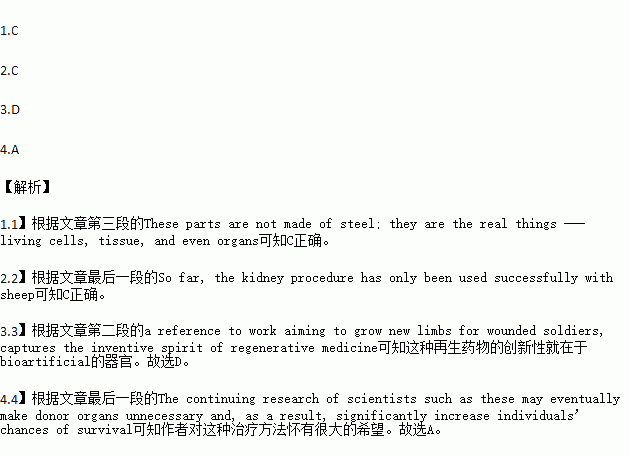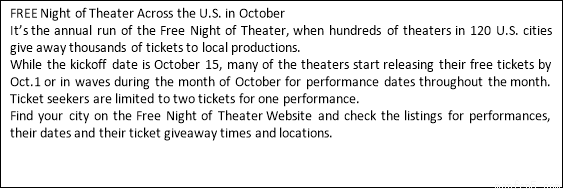题目内容
For centuries, medical pioneers have refined a variety of methods and medicines to treat sickness, injury, and disability, enabling people to live longer and healthier lives.
“A salamander (a small lizard-like animal) can grow back its leg. Why can't a human do the same?” asked Peruvian-born surgeon Dr. Anthony Atala in a recent interview. The question, a reference to work aiming to grow new limbs for wounded soldiers, captures the inventive spirit of regenerative medicine. This innovative field seeks to provide patients with replacement body parts.
These parts are not made of steel; they are the real things --- living cells, tissue, and even organs.
Regenerative medicine is still mostly experimental, with clinical applications limited to procedures such as growing sheets of skin on burns and wounds. One of its most significant advances took place in 1999,when a research group at North Carolina’s Wake Forest Institute for Regenerative Medicine conducted a successful organ replacement with a laboratory-grown bladder. Since then, the team, led by Dr. Atala, has continued to generate a variety of other tissues and organs 一 from kidneys to ears.
The field of regenerative medicine builds on work conducted in the early twentieth century with the first successful transplants of donated human soft tissue and bone. However, donor organs are not always the best option. First of all, they are in short supply, and many people die while waiting
for an available organ; in the United States alone, more than 100,000 people are waiting for organ transplants. Secondly, a patient’s body may ultimately reject the transplanted donor organ. An advantage of regenerative medicine is that the tissues are grown from a patient’s own cells and will not be rejected by the body’s immune system.
Today, several labs are working to create bioartificial body parts. Scientists at Columbia and Yale Universities have grown a jawbone and a lung. At the University of Minnesota, Doris Taylor has created a beating bioartificial rat heart. Dr. Atala’s medical team has reported long-term success with bioengineered bladders implanted into young patients with spina bifida (a birth defect that involves the incomplete development of the spinal cord). And at the University of Michigan, H. David Humes has created an artificial kidney.
So far, the kidney procedure has only been used successfully with sheep, but there is hope that one day similar kidney will be implantable in a human patient. The continuing research of scientists such as these may eventually make donor organs unnecessary and, as a result, significantly increase individuals’ chances of survival.
1.In the latest field of regenerative medicine, what are replacement parts made of?
A. Donated cells, tissues and organs.
B. Rejected cells, tissues and organs.
C. Cells, tissues and organs of one’s own.
D. Cells, tissues and organs made of steel.
2.What have scientists experimented successfully on for a bioartificial kidney?
A. Patients. B. Rats.
C. Sheep. D. Soldiers.
3.Why is regenerative medicine considered innovative?
A. It will provide patients with replacement soft tissues.
B. It will strengthen the human body’s immune system.
C. It will shorten the time patients waiting for a donated organ.
D. It will make patients live longer with bioartificial organs.
4.What is the writer’s attitude towards regenerative medicine?
A. Positive. B. Negative.
C. Doubtful. D. Reserved.
“I invented a new word. How do I get it into the dictionary?”
This is, by far, the question lexicographers(词典编纂者)hear the most. People invent new words all the time, but which ones actually make it into the dictionary? When lexicographers decide what words to add to dictionaries, they try to imagine what words users actually want to look up. There are important factors to keep in mind here.
1)Is the word in widespread usage?
The usage question is an important one that gets at the heart of how dictionaries are written. When modem lexicographers try to add words to dictionaries, they tend to approach their work from the angle of descriptivism — that is, they observe how the language is being used, see if it, s a common phenomenon, and then write definitions based on their research.
2)Does the word have staying power?
Widespread usage does not, however, guarantee a word a shiny new definition in a dictionary. Is the word going to stay around for a while, or is it just a passing fad? Is it likely to be in use in 5, 10, 20, or even 100 years? These are important questions to ask because there are far more updates and new words to be added to dictionaries than lexicographers have time to write.
3)Are you famous? Do you have influence?
If you’re famous, that could definitely up your chances of getting a word into a dictionary. Are you a writer? That could help. Take, for example, William Shakespeare, who invented (or at least popularized) hundreds of words and phrases commonly used today. Politicians also make their contributions. Abraham Lincoln invented the word neologize, and Winston Churchill has the first citation(引语)in the OED for many words, including fluffily and fly-in. So if you’re a person with influence and a following, the words you use can spread into common usage, which, as discussed above, is very important when it comes to gaining dictionary-entry.
4)Does the word fill a gap in the language?
If you’re not famous, there are other ways. Maybe you’re a scientist introducing new concepts to the public. Take, for example, the Higgs Boson particle(粒子), named after physicist Peter W. Higgs. But you don’t have to be a scientist to get your word a dictionary entry. Just look at Dominique Ansel, the pastry chef (糕点师) who captured the stomachs of New Yorkers with his dessert, the cronat. His invention even inspired copycats in the form of doissants and daffins.
Apart from these, it does sometimes help if the word is fun to say. The term blog is relatively new, which arose in 1999 when Peter Merholz made a light-hearted comment on the sidebar of his “weblog” telling his readers “I’ve decided to pronounce the word ‘weblog’ as wee’-blog. Or ‘blog’ for short.” And there’s also Dr. Seuss, who invented the term nerd.
So, why do some words make it into dictionaries while others don’t? With the knowledge discussed above in hand, the answer is more than obvious. Go forth! Use language creatively! Lexicographers are listening!
Title: How does a word gain 1.into the dictionary? | ||
Reasons | Details | Examples |
Being used 2. | With the approach of descriptivism, modem lexicographers will observe how commonly a word is used and 3.it according to their research. | |
Having staying power | The 4. a word remains in use, the more likely it is to be put into the dictionary. | |
Being invented by famous people | Chances of dictionary entry also 5. if the new word is invented by people of importance and influence. | hundreds of words and phrases invented by literary figures and 6.. |
7.a gap in the language | If a word introduces new scientific concepts, or 8. new inventions, it will probably get into the dictionary. the Higgs Boson particle; cromit, doissants, duffins | the Higgs Boson particle; cromit, doissants,duffins |
Being fun to say | Some words make it into dictionaries because they carry a 9.of fun when you use them. | 10.nerd |




